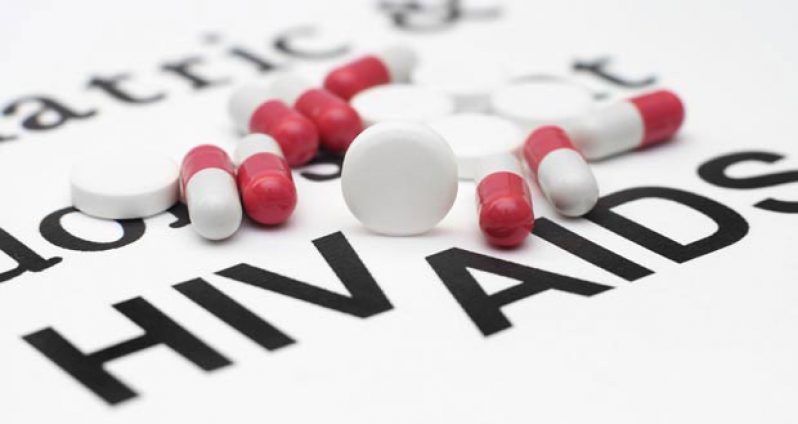– 85% of infected persons on gov’t-run treatment programme
By Navendra Seoraj
JUST over one thousand new HIV cases have been recorded in Guyana during the past six years; and an average of 85% of all infected persons are on the government-run treatment programme, the Pan American Health Organization (PAHO) has reported.A reflection on the fight against HIV and AIDS would show that Guyana has progressed a long way in trying to eradicate the scourge. After peaking in 2006, HIV/AIDS cases stabilised to approximately 1,035 in the last six years (2010-2015).
The Pan American Health Organization/World Health Organization (PAHO/WHO) Health @ 50 Report disclosed that, in the initial stages of the epidemic, AIDS was a reportable condition. Guyana recorded its first case of AIDS in 1987, and AIDS cases have since progressively increased, reaching a peak of 435 in 2001. Thereafter, there was a decrease in the trend until 2015, when WHO made HIV infection a reportable condition and Guyana concurred with the need to report HIV infection.
Looking back on the fight against the virus as Guyana progressed, the country reported on AIDS cases diagnosed mainly in the public health sector. From the beginning of the HIV/AIDS epidemic in Guyana until 2008, when CD4 testing became routinely available, the National AIDS Programme (NAP) used the Caribbean Epidemiology Centre (CAREC) clinical criteria to diagnose AIDS cases.
These criteria included the identification of any AIDS indicator disease (all of which required laboratory testing that were not available in Guyana) or the presence of two clinical AIDS defining conditions, such as unexplained weight loss of more than 10 percent of body weight and diarrhoea for more than a month, plus a positive HIV test.
When CD4 testing became routinely available, a CD4 count equal to or less than 200 cells per mm3 was used to diagnose AIDS.
“This changed to a count equal to, or less than, 350 cells per mm3, in 2010. Since CD4 testing was not consistently available initially, there may have been underreporting of AIDS cases in some years,” PAHO highlighted
PREDOMINANCE RATIO
In the early stage of the HIV/AIDS epidemic in Guyana, males were predominantly more affected than females, with ratios as high as 4:1. From the late 1990s, females started to be infected at a higher rate than their male counterparts; and by 2004, HIV and AIDS cases were equally distributed in both sexes.
From 1999 to 2006, the majority of persons with HIV/AIDS fell within the 25-to-49-years age range, with most cases within a single age group occurring in persons between 35 and 39 years of age.
At the time that the first case of AIDS was reported in Guyana, the country was classified as a Highly Indebted Poor Country (HIPC) by the World Bank, and there were little resources to combat the epidemic. However, through the support of the Global Programme on AIDS (GPA) and financial and technical assistance from the CAREC, the country established the National AIDS Programme Secretariat in 1989, and subsequently the Genito-Urinary Medicine (GUM) Clinic for voluntary counselling and testing (VCT), the National Laboratory for Infectious Diseases (NLID), and the National Blood Transfusion Service (NBTS).
In 1992, the National AIDS Committee (NAC) was established to provide policy guidance and advocacy, and the Regional AIDS Committees (RAC) in the 10 regions of the country were established.
The NAC was also responsible for advising the minister and promoting networking with non-governmental organizations (NGOs).
Also, in 2005, through the advocacy of the United Nations (UN) Theme Group on HIV/AIDS, and in order to fulfill a requirement of the World Bank grant, the country established the Presidential Commission on HIV/AIDS (PCHA), the role of which was to coordinate the multi-sectoral response.
PMTCT PROGRAMME
The report underscored that the prevention of mother-to-child transmission (PMTCT) programme, started as a pilot at seven health facilities in Regions 4 (Demerara/Mahaica) and 6 (East Berbice/Corentyne) in 2001,
provides HIV counselling and testing of pregnant women in the antenatal period, during labour and delivery at public and private health care facilities in all 10 regions of the country.
Counselling and testing are also offered to male partners of the women. Women who are infected with HIV are treated with antiretrovirals (ARVs) during labour and delivery.
“ARVs are also given to their newborn as early as possible after birth, preferably within 48 hours. Babies born to HIV-infected women in the PMTCT programme are also tested for HIV through DNA PCR techniques within the first 6 months, and by ELISA at 18 months.”
By the end of 2014, there were 188 points of care (ANC, labour and delivery) providing this service to pregnant women, indicating that the PMTCT programme is one of the health programmes in which there is widespread access to all segments of the population, including persons in the hinterland communities.
From 2002, PMTCT programmatic data on the prevalence of HIV among pregnant women revealed that the prevalence was 3.5 percent. There followed a consistent reduction up to 2009, after which there was an increase to 1.9 percent in 2013 and 2014. Related to the reduction in HIV prevalence among antenatal women in the PMTCT programme was a reduction in the proportion of babies born to HIV-infected mothers who also tested positive for HIV.
Treatment is one of the areas that the National AIDS Programme Secretariat (NAPs) has had good success.
“Of persons who have enrolled into the care and treatment programme, the proportion that had actually commenced treatment with anti-retroviral medications had increased from around 70 percent in 2009 to 85 percent in 2014,” the PAHO reported noted.
The estimated number of persons living with HIV, who require treatment and are actually receiving it, is unknown. It is believed that treatment with ARVs would have increased survival of persons with AIDS/Advanced HIV infection, and contributed to the reduction in mortality due to AIDS and advanced HIV infection.




.jpg)










